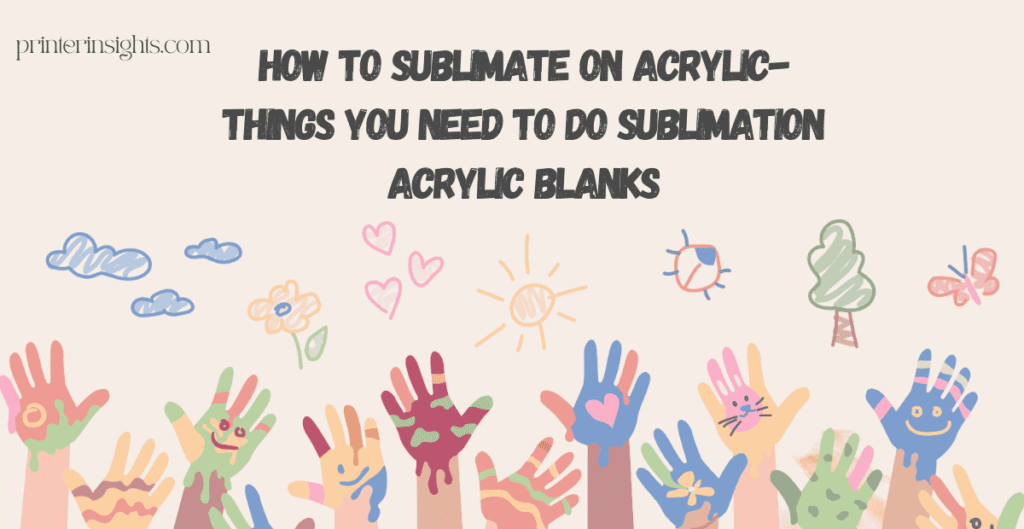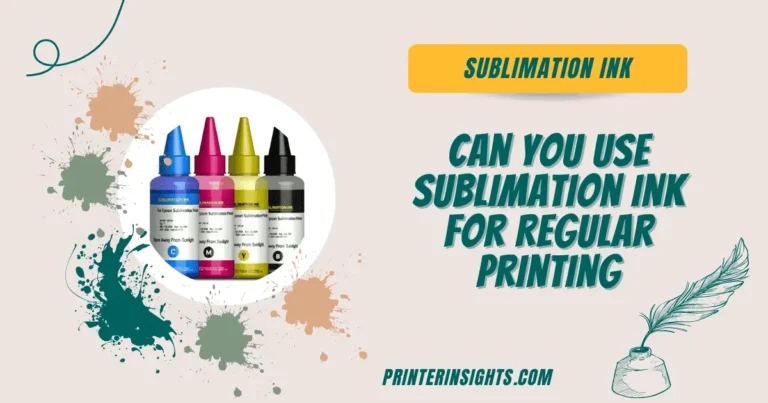Can You Sublimate On Acrylic
Do you want to know that can you sublimate on acrylic? All of the information you require is provided. Read on.

One way to be creative is to use sublimation to make personalized items that can be given as gifts or sold for money. As more people look for ways to create t-shirts, caps, mugs, beanies, and keychains, sublimation businesses are growing by leaps and bounds.
Have you ever wanted to know if you can do sublimation on acrylic? Yes, you can do sublimation on acrylic.
However, unlike porous materials, acrylic is non-porous, so it requires special treatment. The process involves using a sublimation coating specifically designed for acrylic surfaces.
Once coated, you can print your design onto sublimation paper and transfer it onto the acrylic using a heat press, resulting in vibrant and durable images. Ensure to follow manufacturer instructions for best results.
Keep reading to find out how can you sublimate on acrylic and make trendy keychains, frames, or tiles that you can do yourself. Let’s dive in and learn more about the fascinating world of sublimation on acrylic.
Related Post: Can You On Sublimate Glass
[adinserter block=”1″]
Key Takeaways:
- Yes, you can sublimate on acrylic, but it requires special treatment due to its non-porous nature. Use a sublimation coating designed for acrylic surfaces, then print your design onto sublimation paper and transfer it using a heat press for vibrant images.
- To sublimate on acrylic, you’ll need a sublimation printer, inks, paper, and a heat press. Ensure they’re compatible with sublimation and follow manufacturer guidelines for best results.
- Design your artwork on a computer using sublimation software, then print it onto sublimation paper in mirror mode. Trim the paper to fit your acrylic blank and remove any protective coating.
- Place the printed sublimation paper face-down on the acrylic blank, secure it with heat-resistant tape, and then heat press at the recommended settings. After pressing, remove the paper to reveal your design.
- Sublimating on acrylic offers a creative way to personalize items. With the right tools and techniques, you can achieve professional-quality results and start your own customization business.
[adinserter block=”1″]
Can I Sublimate on Acrylic?
Using clear acrylic as a sublimation blank is an especially interesting way to go in this area. It’s like a blank canvas ready to be filled with your unique style.
Depending on the type of acrylic used, the final result can look different and have different functions. This gives artists and crafters a wide range of options to try out.
The Cricut, an electronic cutting machine that can be used for many things and has become associated with accuracy and creativity, is one of the tools helping this journey of change.
The Cricut can cut through many materials, even clear acrylic, very precisely. This makes it possible to make personalized drawings and patterns with even more detail.
When sublimation plates, clear acrylic, and the Cricut come together, the creative possibilities grow. People can now make their ideas into real, personalized works of art that go beyond the limits of traditional art.
Related Post: Can You Sublimate on Silicone?
[adinserter block=”1″]
How to Sublimate On Acrylic- Things You Need to Do Sublimation Acrylic Blanks:

Sublimating on acrylic sheets or blanks may look like fun, but if you don’t use the right tools or the right amount of heat or pressure, the effects could turn you off.
If you don’t have the right gear with you. So, shall we talk about them?
1) Ink, paper, and a Sublimation Printer:
For any type of dye sublimation, you need a sublimation printer, ink, and paper. Taking into account what you need and how you will be using the printer, buy one that is the best quality and size for your business or personal wants.
The sublimation equipment used has everything to do with the quality of the result. For instance, the Epson EcoTank ET-15000 and ET-8550 are good sublimation printers that print very well. If you use good sublimation ink, your print will also be very good.
The same is true for sublimation paper that sticks to plexiglass. The main point is that all of these things are important to the melting process.
2) Heat Press Machine:
To press print onto the plastic surface, you need a regular heat press. You can even get a compact Easy Press, but it doesn’t have as many features.
The heat press uses high temperatures to move the ink from the sublimation paper to the next surface. The temperature range for regular sublimation is between 350oF and 400oF.
The ink soaks in faster when the temperature is higher.
3) Blanks, Sheets, and Fabric Made of Acrylic:
For the base, we need clear acrylic sheets for keychains, and white acrylic sheets for t-shirts and caps, or fabrics.
Because straight sublimation can’t be done on dark or black shirts. That won’t work out too well because it will be on a white surface.
4) Vinyl or White Spray Paint (optional):
If your acrylic sheet is see-through, you should use a white vinyl or spray sheet because a see-through acrylic sheet makes a cloudy picture that looks better with a white background.
5)Butcher Paper or Heat Tape:
The plastic surface and printed paper are stuck together in the right place with heat tape. That way it won’t move while it’s being heated.
Butcher paper is an extra item that keeps the sublimation paper and plastic surface from getting damaged by the heat press.
6)Software for Designing Sublimation:
If a customer asks for a custom logo for their business, you need good sublimation design software if you want your customization business to grow.
If you want to make a personalized picture or change the settings on a printable photo. There are a lot of good design tools out there, both free and paid. It’s easy to find one that works for you.
Related Post: Can You Sublimate on Canvas
[adinserter block=”1″]
Smart Way to Sublimate on Acrylic Surfaces:
The primary benefit of using acrylic as a sublimation substrate is that, unlike canvas and natural fabrics, it does not require an additional polymer coat to absorb the sublimation ink.
Let us now proceed with the intelligent method for sublimating acrylic surfaces.
- Measure the dimensions of the acrylic block and maintain a 1 to 2-inch margin around its perimeter.
- Utilize sublimation software to resize or design the print following the client’s specifications. Utilize sublimation paper to print it.
Note:
Sublimation paper must be larger than the acrylic surface or sheet. This prevents the transfer of the paper impressions onto the transparent acrylic.
- Cleaning both acrylic surfaces and removing any plastic lining or covers that were applied to them.
- Preheat the heat press to 389 degrees Fahrenheit or 180 degrees Celsius. As the heat press warms, position the non-printing side of the acrylic sheet over it to preheat it.
As a result, the acrylic will not be distorted by the heat press’s abrupt temperature increase.
- Adhere the paper design side to the acrylic sheet on its printing side using thermal tape. Tightly seal it to guarantee that the image is positioned at the intended angle and is immobile.
- In the sixth step, position the acrylic and image pieces onto the heat press. Position the heat tape atop the pieces with the non-printable surface facing downwards.
- Place each acrylic piece between two sections of butcher paper before replacing the heat press lid.
- Maintain the acrylics at a median temperature of 389 degrees Fahrenheit or 180 degrees Celsius.
It must be retained for a minimum of sixty seconds and a maximum of one hundred seconds, contingent upon the acrylic’s thickness.
- Take the plastic pieces out of the heat and let them cool down. It’s best to soak them in cold water so that their face doesn’t get distorted.
The pattern is perfectly printed on a clear acrylic sheet. Take off the heat tape and paper and turn around to see it.
Extra step:
If you want to make the colors in your design stand out more on the clear acrylic, spray paint the printed side with white spray paint or stick vinyl tiles to it. The personalized item stands out against the white background.
[adinserter block=”1″]
How to Get Your Design Ready For Sublimation on Acrylic:
Before you start sublimating, make sure your image is the right size and format.
The first step is to open your drawing in any editing software you like. Then, change the size of your image so that it fits the base. Say you want to sublimate on a t-shirt. You’ll need to change the size of your image to fit the t-shirt.
You should save your drawing as a PNG file after you’ve changed its size. The clear background around your image will stay the same with this file type, which is important for the sublimation process.
[adinserter block=”1″]
Instructions on How to Print Your Image on Acrylic Fabric:
It’s time to put your design on fabric now that your design file is ready for sublimation!
For this, you’ll need to switch your sublimation printer to “mirror” mode so that the image prints backward on the heat transfer paper. Then, follow the manufacturer’s guidelines to put your transfer papers (also called sublimation papers) into the sublimation printer.
Now we’ll talk about the sublimation coating for plastic. Once your paper is sublimated, cut it out so that the edges are as close to the pattern as you can get them. After that, put the printed side down on the fabric and use a heat press to melt the design into the cloth.
To get the best results, put a piece of parchment paper over the pattern to protect it before you apply heat. The manufacturer’s directions will tell you more about how to set up your heat press according to the type of fabric you’re using.
[adinserter block=”1″]
Can You Sublimate On Acrylic Keychains?
Sublimate on acrylic keychain is a fantastic way to create personalized and vibrant designs. Here’s how you can do it:

Materials Needed
1) Sublimation Printer:
Ensure it’s compatible with sublimation inks and has a resolution of at least 1440 dpi for optimal print quality.
2) Sublimation Inks:
These special inks turn into gas during the sublimation process.
Sublimation paper: Use paper coated with a polymer layer to receive the printed ink.
3) Design and Print:
Design your artwork on a computer using sublimation software.
Print the design on sublimation paper using sublimation ink.
4) Preheat Your Heat Press:
Set the heat press to the recommended temperature.
5) Position the Keychain:
Place the sublimation paper with the design facing down on the acrylic keychain.
6) Press:
Press the keychain with the heat press for the recommended time (usually around 60 seconds).
7) Assemble:
Peel off your sublimation print and assemble the keychain with a keyring and jump rings.
Remember to handle the acrylic keychain while it’s still hot to shape it if needed. Enjoy creating beautiful and personalized acrylic keychains!
[adinserter block=”1″]
Can You Sublimate On Acrylic Ornaments?
Yes, you can sublimate on acrylic! Acrylic blanks are ideal for sublimation, offering a versatile canvas for vibrant and permanent designs when heat-pressed. Here’s how you can do it:
1) Prepare Your Design:
Print your desired design on sublimation paper using a sublimation printer with sublimation ink.
Make sure your image is sized to fit your acrylic blank. Trim the paper slightly larger than the blank to avoid marks from the edge of the paper.
2) Prep the Acrylic Blanks:
- Remove the protective coating from the acrylic blank.
- Spray a light coat of heat-resistant spray (such as Pro Spray) onto the design side of your print. This step helps the ink adhere better during sublimation.
3) Heat Press:
- Place the sprayed print face-down on the acrylic blank.
- Secure the paper using heat-resistant tape or other methods.
- Heat press the acrylic at a temperature of 385-400°F for 60 seconds.
Remember that only cast acrylic can withstand the heat needed for sublimation, so make sure you’re using the right type of acrylic for your projects.
[adinserter block=”1″]
Bottom Line: Sublimate On Acrylic
If you want to start your own design business, you need to know how to sublimate on acrylic sheets. If you do it right, sublimating acrylic blanks can give you beautiful, professional effects.
If you do these things, you’ll be well on your way to making a great unique acrylic item. When you use a heat press, don’t forget to always be safe and follow the manufacturer’s instructions.
We hope that this article has helped you understand what you need and how can you sublimate on acrylic. You should be excited and ready to open your customization glass shop.
[adinserter block=”1″]
FAQ
Last Updated on May 22, 2024 by Muhammad Haseeb






